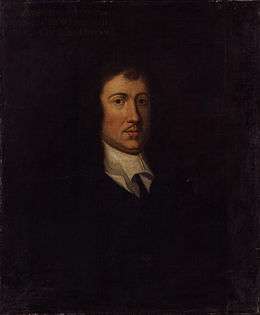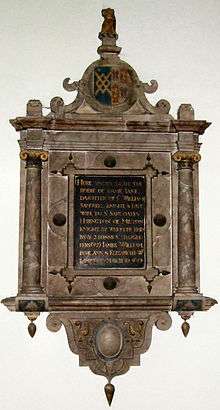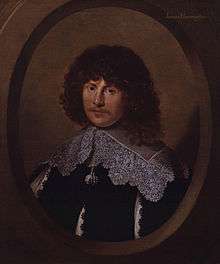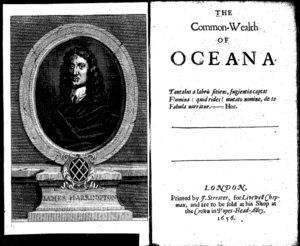James Harrington (author)
James Harrington (or Harington) (3 January 1611 – 11 September 1677) was an English political theorist of classical republicanism.[1] He is best known for his controversial publication The Commonwealth of Oceana (1656). This work was an exposition on an ideal constitution, designed to facilitate the development of a utopian republic.

Early life

Harrington was born in 1611 in Upton, Northamptonshire, the eldest son of Sir Sapcote(s) Harrington of Rand, Lincolnshire who died 1629, and Jane Samwell of Upton, daughter of Sir William Samwell. He was the great-nephew of John Harington, 1st Baron Harington of Exton, who died in 1613. He was for a time a resident, with his father, in the manor house at Milton Malsor, Northamptonshire. A blue plaque on Milton Malsor Manor marks this.
Holy Cross Church in Milton Malsor contains a monument on the south wall of the chancel to Harrington's mother, Dame Jane Harrington.[2] According to the memorial, she died on 30 March 1619, when James was 7 or 8 years old. The memorial reads, in modern English but punctuated as in the original
"Here under lies the body of Dame Jane, daughter of Sir William Samwell Knight, & late wife to Sir Sapcotes Harington [sic] of Milton Knight, by whom he had issue 2 sons & 3 daughters, viz James, William, Jane, Anne & Elizabeth. Which Lady died March 30, 1619".
Childhood and education
Knowledge of Harrington's childhood and early education is practically non-existent; both, it seems, were conducted at the family manor in Rand. In 1629, he entered Trinity College, Oxford as a gentleman commoner and left two years later with no degree. For a brief time, one of his tutors was the royalist High Churchman William Chillingworth. He entered then abruptly left the Middle Temple despising lawyers forever, an animus which later appeared in his writings.
Youth

By this time, Harrington's father had died, and his inheritance helped pay his way through several years of continental travel. He enlisted in a Dutch militia regiment (apparently seeing no service), before touring the Netherlands, Denmark, Germany, France, Switzerland and Italy. He was in Geneva with James Zouche in the summer of 1635 and subsequently travelled to Rome where on 14 January 1636 he dined at the Jesuit-run English College with Zouche and perhaps Henry Neville or his elder brother Richard.[3] In the light of this, Toland's reference to his visiting the Vatican, where he "refused to kiss the Pope's foot", probably refers to early 1636; meanwhile his visit to Venice helped bolster his knowledge of an enthusiasm for the Italian republics. Harrington returned to England in the same year. The following decade, including his comings and goings during the Civil Wars, are largely unaccounted for by anything other than unsubstantiated stories of the ilk: that he accompanied Charles I to Scotland in 1639 in connection with the first Bishops' War; and that he came to Parliament's financial assistance with loans and solicitations in 1641–42 and in 1645. Otherwise, he appears to have simply "resided at Rand, an unmarried country gentleman of studious tastes."
Harrington's apparent political loyalty to Parliament did not interfere with a strong personal devotion to the King. Following the capture of Charles I, Harrington accompanied a "commission" of MPs appointed to persuade Charles to move from Newcastle to Holdenby House (Holmby), as to be nearer London. When a further attempt was made to forcibly transfer the King to the capital, Harrington successfully intervened. In May 1647, he became a gentleman groom of the royal bedchamber; we see him acting in that capacity through the end of the year and also in 1648 at Hurst Castle and at Carisbrooke Castle. Sometime around New Year 1649, his attendance on the King was abruptly terminated by parliamentarians furious, it is said, over his refusal to swear to report anything he might hear of a royal escape attempt.
At least two contemporary accounts have Harrington with Charles on the scaffold, but these do not rise above the level of rumour.
Oceana
| Part of the Politics series on |
| Republicanism |
|---|
|
Types of republics |
|
History
|
|
Related topics |
| Politics portal |
After Charles' death Harrington devoted his time to the composition of his The Commonwealth of Oceana. By order of England's then Lord Protector Oliver Cromwell, it was seized when passing through the press. Harrington, however, managed to secure the favour of Cromwell's favourite daughter, Elizabeth Claypole; the work was restored to him, and appeared in 1656, newly dedicated to Cromwell.[4] The views embodied in Oceana, particularly those bearing on vote by ballot and rotation of magistrates and legislators, Harrington and others (who in 1659 formed a club called the "Rota") endeavoured to push practically, but with no success.[5]
Editorial history
Harrington's manuscripts have vanished; his printed writings consist of Oceana, and papers, pamphlets, aphorisms and treatises, many of which are devoted to its defence. The first two editions are known as the "Chapman" and the "Pakeman". Their contents are nearly identical. His Works, including the Pakeman Oceana and the somewhat important A System of Politics, were first edited with biography by John Toland in 1700.[6] Toland's edition, with numerous substantial additions by Thomas Birch, appeared first in Dublin in 1737 and 1758, and then in England in 1747 and 1771. Oceana was reprinted in Henry Morley's Universal Library in 1883; S.B. Liljegren reissued a fastidiously prepared version of the Pakeman edition in 1924.
Harrington's modern editor is J. G. A. Pocock. In 1977, he edited a comprehensive compilation of Harrington tracts, with a lengthy historical introduction. Harrington's prose was marred by what Pocock described as an undisciplined work habit and a conspicuous "lack of sophistication." He never attained the level of "a great literary stylist." For example, as contrasted with Hobbes and Milton, "nowhere" to be found are:
"important shades of meaning...conveyed [through] rhythm, emphasis and punctuation; ...He wrote hastily, in a baroque and periodic style in which he more than once lost his way. He suffered from Latinisms...his notions of how to insert quotations, translations and references in his text were at times productive of confusion."[7]
Imprisonment
Following the Stuart Restoration, on 28 December 1661, Harrington was arrested on a charge of conspiring against the government in the "Bow Street" cabal[8] and, without a trial, was thrown into the Tower. There, he was "badly treated" until his sisters succeeded in bribing his jailers to obtain a writ of habeas corpus. Before it could be executed, however, the authorities rushed him to St Nicholas Island off the coast of Plymouth. Other relatives won Harrington's release to the fort at Plymouth by posting a £5000 bond. Thereafter, his general state of health promptly plunged and quickly deteriorated, apparently from his ingestion on medical advice of the addictive drug guaiacum.[9] Harrington's mind appeared to be affected. He suffered "intermittent delusions;" one observer judged him "simply mad." He recovered only slightly, then slipped decidedly downhill. He proceeded to suffer attacks of gout and palsy before falling victim to a paralysing stroke. In 1675, just two years before his death, he married "a Mrs Dayrell, his 'old sweetheart'", the daughter of a Buckinghamshire noble.
Harrington died at Little Ambry, Dean's Yard, Westminster. He was buried next to Sir Walter Raleigh in St Margaret's, Westminster. There is a slate wall memorial to him at St Michael's Church, Upton.[10]
Harrington has often been confused with his cousin Sir James Harrington, 3rd Baronet of Ridlington, MP, a member of the parliamentary commission which tried Charles I, and twice president of Cromwell's Council of State. He was subsequently excluded from the Indemnity and Oblivion Act which pardoned most for taking up arms against the King during the Civil Wars (1642–46).
See also
- Gawthorpe Hall has a picture of Harrington
Notes

- "England's premier civic humanist and Machiavellian. He was not the first to think about English politics in these terms..., but he was the first to achieve a paradigmatic restatement of English political understanding in the language and world-view inherited through Machiavelli." Pocock, "Intro", p. 15.
- "James Harrington". Milton Malsor Historical Society. Retrieved 22 March 2008.
- Edward Chaney, The Grand Tour and the Great Rebellion: Richard Lassels and 'The Voyage of Italy' in the Seventeenth Century (Geneva, 1985), pp. 285–86)
- Pocock writes that this explanation of Cromwellian censorship "has the authority of family tradition, but is not especially convincing." More credible, he finds, is that Oceana criticizes the Protectorate's maintenance of a standing army (in order to hold power), a concept clearly denounced in Oceana and other English republican tracts of the time, in favor of locally controlled regiments (militia). Pocock, "Intro", 8–9.
- the Rota being "a select debating society" which conducted "high quality discussions" where "proposals were formally voted on" by members of "salience", which may have included Samuel Pepys. Höpfl, ODNB, p. 388.
- The Oceana and other Works of James Harrington, with an account of his Life by John Toland.
- Pocock, "Intro", p. xv.
- a "circle of Commonwealthsmen [radical republican] 'plotters'." Höpfl, ODNB, p. 390.
- tincture of the lingum resin of a West Indies tree, "best known as a remedy in gout and rheumatism and as a diuretic." see John Henry Clarke, M.D., Dictionary of Practical Materia Medica.
- Historic England. "Church of St Michael, Upton (1372152)". National Heritage List for England. Retrieved 9 April 2015.
References
- H.M. Höpfl, "Harrington, James", Oxford Dictionary of National Biography, vol. 25, eds. H.C.G. Matthew; Brian Harrison (Oxford: 2004), 386–391. cited as 'Höpfl, ODNB'.
- J.G.A. Pocock, "Editorial and Historical Introductions", The Political Works of James Harrington (Cambridge: 1977), xi–xviii; 1–152. [hb: ISBN 0-521-21161-1]; cited as 'Pocock, "Intro"'.
![]()
Further reading
- Blitzer, Charles. An Immortal Commonwealth: the Political Thought of James Harrington (Hamden, Conn.: Archon Books, 1970;1960); ISBN 0-208-00811-X.
- Cotton, James. James Harrington's Political Thought and its Context (New York: Garland Pub., 1991); ISBN 0-8153-0130-8.
- Dickinson, W. Calvin. James Harrington's Republic (Washington, DC: University Press of America, 1983); ISBN 0-8191-3019-2.
- Downs, Michael. James Harrington (Boston: Twayne Pubs., 1977); ISBN 0-8057-6693-6.
- Pocock, J.G.A. "Interregnum: the Oceana of James Harrington", chapter 6 in Pocock, The Ancient Constitution and the Feudal Law: a Study of English Historical Thought in the Seventeenth Century, a reissue with a retrospect (Cambridge: 1987;1957); [pb: ISBN 0-521-31643-X].
- Pocock, J. G. A. “James Harrington and the Good Old Cause: A Study of the Ideological Context of His Writings.” Journal of British Studies' 10#1 1970, pp. 30–48. online
- Pocock, The Work of J.G.A. Pocock: Harrington section.
- Robbins, Caroline. The Eighteenth-Century Commonwealthman: Studies in the Transmission, Development, and Circumstance of English Liberal Thought from the Restoration of Charles II until the War with the Thirteen Colonies (1959, 2004).
- Russell-Smith, Hugh Francis. Harrington and his Oceana; a story of a 17th century Utopia and its influence in America (New York: Octagon Books, 1971); ISBN 0-374-96996-5.
- Scott, Jonathan. "The Rapture of Motion: James Harrington's Republicanism", in Nicholas Phillipson; Quentin Skinner, eds. Political Discourse in Early Modern Britain (Cambridge: 1993), 139–163; ISBN 0-521-39242-X.
External links
| Wikimedia Commons has media related to James Harrington. |
